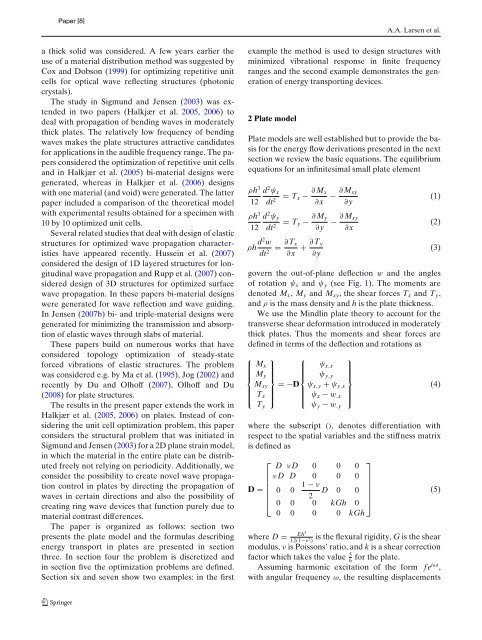WAVES AND VIBRATIONS IN INHOMOGENEOUS STRUCTURES ...
WAVES AND VIBRATIONS IN INHOMOGENEOUS STRUCTURES ...
WAVES AND VIBRATIONS IN INHOMOGENEOUS STRUCTURES ...
You also want an ePaper? Increase the reach of your titles
YUMPU automatically turns print PDFs into web optimized ePapers that Google loves.
a thick solid was considered. A few years earlier the<br />
use of a material distribution method was suggested by<br />
Cox and Dobson (1999) for optimizing repetitive unit<br />
cells for optical wave reflecting structures (photonic<br />
crystals).<br />
The study in Sigmund and Jensen (2003) was extended<br />
in two papers (Halkjær et al. 2005, 2006) to<br />
deal with propagation of bending waves in moderately<br />
thick plates. The relatively low frequency of bending<br />
waves makes the plate structures attractive candidates<br />
for applications in the audible frequency range. The papers<br />
considered the optimization of repetitive unit cells<br />
and in Halkjær et al. (2005) bi-material designs were<br />
generated, whereas in Halkjær et al. (2006) designs<br />
with one material (and void) were generated. The latter<br />
paper included a comparison of the theoretical model<br />
with experimental results obtained for a specimen with<br />
10 by 10 optimized unit cells.<br />
Several related studies that deal with design of elastic<br />
structures for optimized wave propagation characteristics<br />
have appeared recently. Hussein et al. (2007)<br />
considered the design of 1D layered structures for longitudinal<br />
wave propagation and Rupp et al. (2007) considered<br />
design of 3D structures for optimized surface<br />
wave propagation. In these papers bi-material designs<br />
were generated for wave reflection and wave guiding.<br />
In Jensen (2007b) bi- and triple-material designs were<br />
generated for minimizing the transmission and absorption<br />
of elastic waves through slabs of material.<br />
These papers build on numerous works that have<br />
considered topology optimization of steady-state<br />
forced vibrations of elastic structures. The problem<br />
was considered e.g. by Ma et al. (1995), Jog (2002) and<br />
recently by Du and Olhoff (2007), Olhoff and Du<br />
(2008) for plate structures.<br />
The results in the present paper extends the work in<br />
Halkjær et al. (2005, 2006) on plates. Instead of considering<br />
the unit cell optimization problem, this paper<br />
considers the structural problem that was initiated in<br />
Sigmund and Jensen (2003) for a 2D plane strain model,<br />
in which the material in the entire plate can be distributed<br />
freely not relying on periodicity. Additionally, we<br />
consider the possibility to create novel wave propagation<br />
control in plates by directing the propagation of<br />
waves in certain directions and also the possibility of<br />
creating ring wave devices that function purely due to<br />
material contrast differences.<br />
The paper is organized as follows: section two<br />
presents the plate model and the formulas describing<br />
energy transport in plates are presented in section<br />
three. In section four the problem is discretized and<br />
in section five the optimization problems are defined.<br />
Section six and seven show two examples: in the first<br />
A.A. Larsen et al.<br />
example the method is used to design structures with<br />
minimized vibrational response in finite frequency<br />
ranges and the second example demonstrates the generation<br />
of energy transporting devices.<br />
2 Plate model<br />
Plate models are well established but to provide the basis<br />
for the energy flow derivations presented in the next<br />
section we review the basic equations. The equilibrium<br />
equations for an infinitesimal small plate element<br />
ρh 3<br />
12<br />
ρh 3<br />
12<br />
d2ψx dt2 = Tx<br />
∂ Mx ∂ Mxy<br />
− −<br />
∂x ∂y<br />
d2ψy dt2 = Ty<br />
∂ My ∂ Mxy<br />
− −<br />
∂y ∂x<br />
ρh d2w ∂Tx ∂Ty<br />
= +<br />
dt2 ∂x ∂y<br />
(1)<br />
(2)<br />
(3)<br />
govern the out-of-plane deflection w and the angles<br />
of rotation ψx and ψy (see Fig. 1). The moments are<br />
denoted Mx, My and Mxy, the shear forces Tx and Ty,<br />
and ρ is the mass density and h is the plate thickness.<br />
We use the Mindlin plate theory to account for the<br />
transverse shear deformation introduced in moderately<br />
thick plates. Thus the moments and shear forces are<br />
defined in terms of the deflection and rotations as<br />
⎧ ⎫ ⎧<br />
⎫<br />
⎪⎨<br />
⎪⎩<br />
Mx<br />
My<br />
Mxy<br />
Tx<br />
Ty<br />
⎪⎬ ⎪⎨<br />
=−D<br />
⎪⎭<br />
⎪⎩<br />
ψx,x<br />
ψy,y<br />
ψx,y + ψy,x<br />
ψx − w,x<br />
ψy − w,y<br />
⎪⎬<br />
⎪⎭<br />
(4)<br />
where the subscript (), denotes differentiation with<br />
respect to the spatial variables and the stiffness matrix<br />
is defined as<br />
⎡<br />
D ν D 0 0 0<br />
⎤<br />
⎢ ν D D<br />
⎢<br />
D = ⎢ 0 0<br />
⎢<br />
⎣ 0 0<br />
0 0<br />
1 − ν<br />
D 0<br />
2<br />
0 kGh<br />
0<br />
0<br />
0<br />
⎥<br />
⎦<br />
0 0 0 0 kGh<br />
(5)<br />
where D = Eh3<br />
12(1−ν2 is the flexural rigidity, G is the shear<br />
)<br />
modulus, ν is Poissons’ ratio, and k is a shear correction<br />
factor which takes the value 5<br />
for the plate.<br />
6<br />
Assuming harmonic excitation of the form feiωt ,<br />
with angular frequency ω, the resulting displacements

















